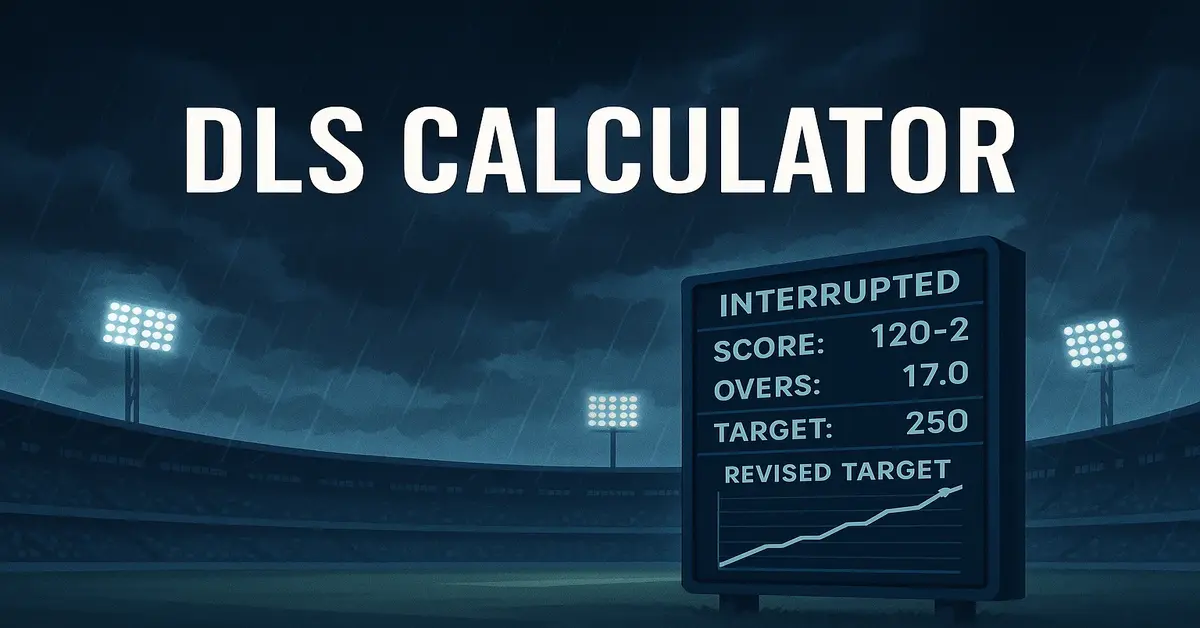DLS Estimator Calculator
In a rain-hit match, when the target changes mid-way and fans are left wondering, “How did they come up with this number?”, it’s usually the DLS method at play. Here is a simple guide which will help you understand the DLS method which is used to determine revised target.
Instructions: How to Use the ICC Resource Table for DLS Calculations
- 🔗 Refer to the official ICC DLS Resource Table: View PDF
- Locate the number of overs remaining in the innings (from 0 to 50).
- Match it with the wickets lost (from 0 to 9) in the corresponding row and column.
- Note down the resource percentage value shown at that combination.
- To find out Resource Used- Use formula: Resourced Used= 100%- Resources Left after Interruption.
- Repeat the process for:
- Start of Team A’s innings
- After each interruption (overs left, wickets lost)
- Start of Team B’s innings
- These resource values are used to calculate:
- Total resources available and used
- Resources remaining after interruptions
- Revised target for Team B
DLS Estimator Calculator
📘 What Are Resources in DLS?
Resources refer to the combination of overs remaining and wickets in hand. The more overs and wickets a team has, the greater their scoring potential.
Resources Used = 100% – Resources Left after Interruption.
Each interruption alters the available resource. This tool calculates using the final cumulative available resource after all interruptions.
📊 Full DLS Resource Table (Overs Left × Wickets Lost)
Values based on official ICC resource table (50 overs = 100% resources)
🌧️ What is the DLS Method?
The Duckworth–Lewis–Stern (DLS) method is a mathematical formula used in limited-overs cricket (ODIs & T20s) to recalculate target scores when matches are interrupted by rain or bad weather.
Originally developed by Frank Duckworth and Tony Lewis, it was later updated by Professor Steven Stern, hence the name DLS.
Why is DLS Needed?
Cricket is unique because both teams don’t always bat under the same conditions. If Team A bats for 50 overs and Team B only gets 30 overs due to rain, a fair comparison is impossible without adjusting the target.
This is where DLS comes in — it considers resources available (overs left + wickets in hand) to set a revised target.
How Does DLS Work (Basic Idea)?
DLS is based on two key resources:
- Overs left
- Wickets in hand
Each team starts with 100% of their resources. As they lose overs or wickets, they lose a percentage of those resources. DLS adjusts the target by comparing how much of the total resource each team had available.
Simplified Example:
- Team A: Scores 250 in 50 overs (uses 100% of resources).
- Rain interrupts.
- Team B: Gets only 30 overs (about 75% of resources depending on wickets).
DLS uses a resource table to calculate how much Team B should score in 30 overs to match the fairness of chasing 250 in 50 overs.
👉 Suppose with 75% resources, the adjusted target becomes 190.
Key Terms in DLS:
- Par Score: The score Team B must be at after a rain break to be on par.
- Revised Target: The new number of runs to chase after adjusting for lost overs.
- Resources Remaining: A % value based on overs and wickets, taken from official DLS tables.
📌 Important Notes:
- DLS only applies in interrupted matches, not regular games.
- It’s used in official ICC matches and is considered fairer than earlier methods.
- Full DLS calculations require licensed software, so online calculators can only offer estimates.
Summary:
DLS helps make rain-affected matches fair by recalculating targets based on resources (overs & wickets) available. It’s like adjusting the rules of a race when the track changes for one runner.


2 thoughts on “DLS Estimator Calculator”